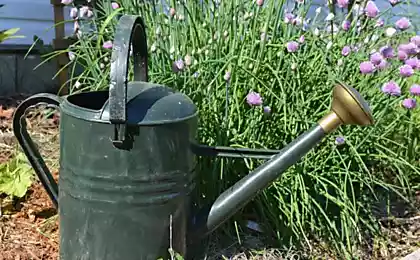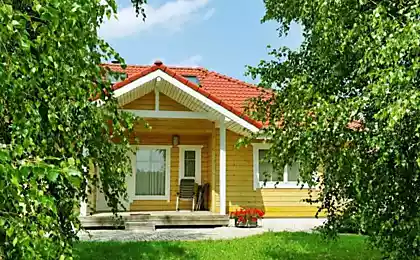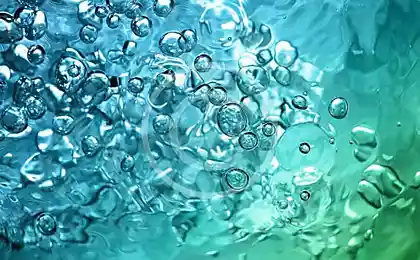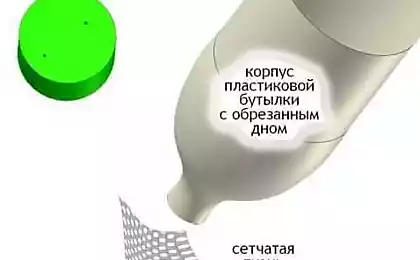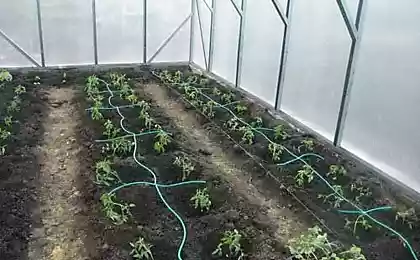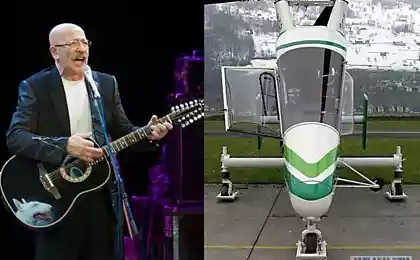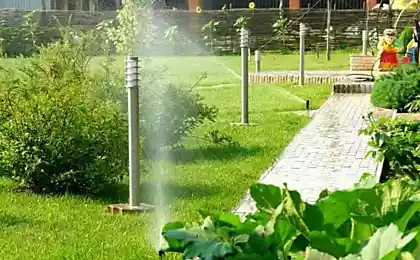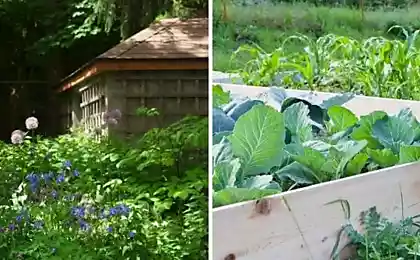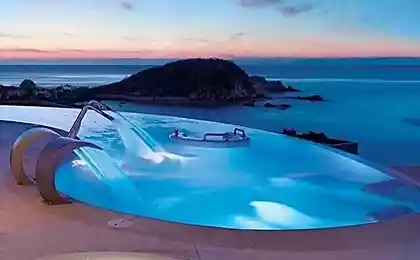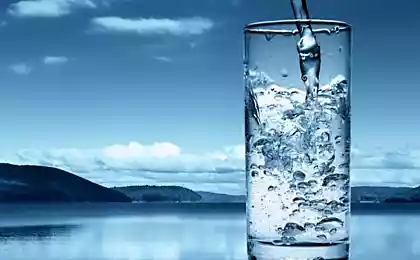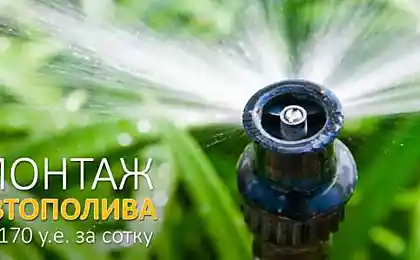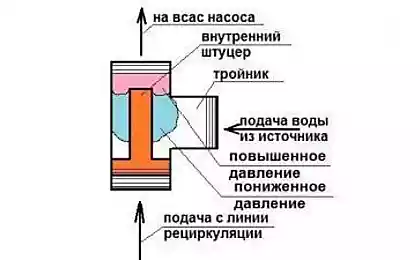959
Automatic irrigation system with your own hands: from mapping to installation
The construction of complex systems, allowing to irrigate areas with a large area is a task of specialized niche companies. While interested master able to build on the site a system that will automatically provide all the planting of life-giving moisture. And if all the calculate correctly, in the area planted, the plants will receive water based on individual needs.
Varieties of watering plants and principles of location of irrigation equipment.
1. Sprinkler system – sprinkler systems that mimic the natural precipitation in the form of rain. Such installations are common due to its simplicity and ease of operation. Typically, they are used for watering lawns and flower beds. The basic principle of the arrangement of nozzles in sprinkler system is that the radius of irrigation of adjacent nozzles should overlap completely. That is, after irrigation on practically should not be left dry patches.
Ideally, polivalki to stand on the vertices of the triangles. In any case, each of the sprinklers should be watering at least one sprinkler.
2. Installer for basal drip (point) irrigation is an irrigation system that delivers water directly in the landing zone of the plant, the direction of the irrigating its root system. Such systems are mainly used for irrigation of trees, shrubs, greenhouses, and garden plants (for watering plants with a deep root system). The principle of arrangement of watering equipment in such systems is that water highway with watering drippers (drip tape) are placed along the planting rows at a small distance from the trunks of plants.

3. Installer for underground (subsurface) irrigation – sprinkler system, the functionality of which is similar to drip irrigation. The main difference is that the porous pipe for irrigation laid under the ground and deliver water directly to the root system of plants.
Humidifiers for subsurface irrigation (pipes with a round or slit-like holes) are located at a depth of 20...30 cm Distance between two adjacent lines is 40...90 cm (depends on the individual characteristics of irrigated culture and the type of soil). The interval between the holes of the humidifier is equal to 20...40 cm, the System of subsoil irrigation is problematic in terms of operation, so few dare to install it on their own site.
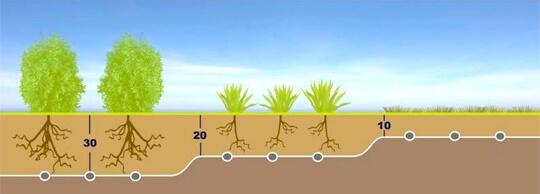
No matter what irrigation method you choose, the design of the automatic irrigation system will be built on the same principles. Significant differences would consist only in the use of different items for watering and that different systems have different working pressure.
So, gravity fed drip systems can function even when the pressure – 0.2 ATM.
The first work on the very small pressure from 0.2 to 0.8 ATM. Roughly speaking, those who have no water supply on the site, you can connect to the tank or barrel. However, the barrel should be raise to 1.5 – 2 meters.In overhead sprinkler irrigation the figure is much higher (several atmospheres). And it depends on the characteristics of the equipment used.
Schematic diagram of irrigation system
The basic elements combined (with the contours of drip and rain irrigation) installation of automatic irrigation shown in the diagram.
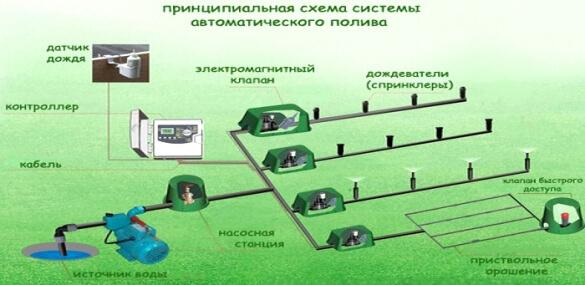
This scheme operates as follows: water from a source (using a pump or by gravity) is delivered to the irrigation zones through pipelines with a diameter of 1 – 1 1/2 inches. Watering zones in this case are equipped with tubes of small diameter (3/4 inch).
In addition to the source, part of an irrigation system is recommended to include storage tank. It could be darkened a tank having a volume of 2 m3 and above (depending on the flow of water when watering). Capacity is equipped with a float sensor fill. If it is put under direct sunlight, it will perform a double function: able to store and heat water in a quantity sufficient for one watering. Filled the tank with tap water, well or well. To prevent the growth of algae inside the tank, it can be darkened with black tape. As the primary water source for the auto-irrigation system, you cannot use natural bodies of water. Microorganisms and algae contained in the water, quickly take the irrigation system out of action. Zone rainfall irrigation are equipped with rotary (dynamic) or fan (static) spray. In areas of drip irrigation, laid the drip tape.
On the same line irrigation should be set to spray only the same type and same model. Otherwise, no one can guarantee their normal functioning. Solenoid valves installed in the distribution unit of water in a given time include the work of a certain contour irrigation.

The opening and closing of the electromagnetic valves are controlled using the controller (it is also called a programmer or computer watering) in accordance with the specified schedule. The programmer, usually installed near the distribution unit of water. The pump starts pumping water into the system automatically (in the time of the fall of pressure in the rail). And the pressure falls as soon as opens the solenoid valve.
To keep the system running smoothly, it is equipped with filters, installed directly into the main water supply.
To prevent clogging the filters, sprinklers, need to install a disk filter at the input or, better, at the outlet of the tank. The pumping station is indicated in the diagram, includes a water reservoir, a fine filter, check valve, purge the node (for preservation of the system in the winter), and a pump that supplies water to the irrigation line.
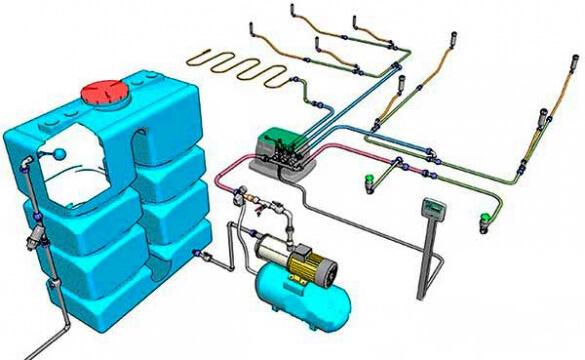
The figure shows the simplest equipment sprinkler systems. Depending on specific needs, the system can be equipped with additional elements, and some devices (for example, main pump, rain sensor, purge the node, solenoid valves, etc.), conversely, may be absent.
Creating a system of automatic irrigation, we have to follow some mandatory steps.
I would like to inform about the steps we will do to achieve the goal:Draw a detailed site plan with all existing objects. The selection and placement of sprinklers in the drawing. Ungrouping sprinkler zones (zone – a territory controlled by one valve). Calculation of hydraulics and pump selection. The calculation of the pipe sections and determination of pressure losses in the system. Buying components. The installation of the system. Steps 3-5 are performed in parallel, because a change to any parameter necessitates changes to the others. For example, if the sprinklers in one zone gets bigger, you need a more powerful pump, and this, in turn, leads to an increase of the pipe sections.
Consider these steps in more detail.
The site plan
The site plan we need to map the placement of watering equipment.

The plan is drawn to scale. It should outline the areas of irrigation, source of water, as well as free-standing plants (e.g., trees) that you plan to irrigate.
Development of a scheme of automatic irrigation
When the site plan is ready, it is possible to trace the route of pipelines. If you plan to create a zone rainfall irrigation, the diagram must indicate the place of installation of sprinklers, as well as their range.
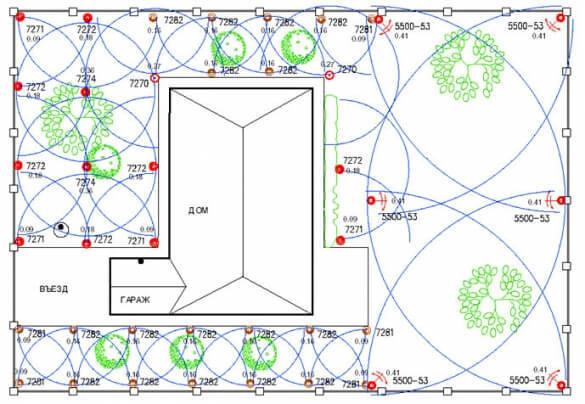

If the area will create a zone of drip irrigation, its lines should also be marked on the overall scheme.
If the distance between the rows of plants, irrigated by drip method, exceeds 40 cm, each series must maintain separate irrigation line. If the specified distance is less, watering can be arranged in rows (to save tubes and droppers).
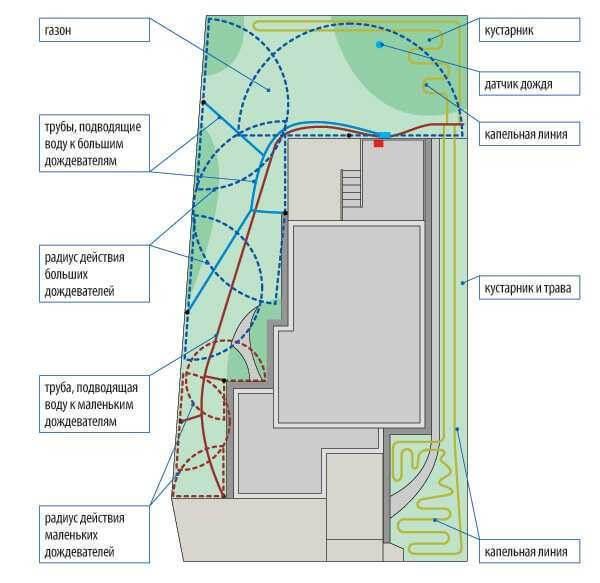
The calculation system
Drawing a detailed scheme of irrigation, it is possible to determine the length of the pipelines and calculate the exact number of points of irrigation (number of sprinklers and drippers).
As for the calculation of the pipe sections, as well as determine the volume of the reservoir and power pumping equipment, it's all very ambiguous. To make accurate calculations you will need to know the norm of watering all plants planted on the plot. Based on computing needs to take the theoretical knowledge of hydrodynamics, and this issue requires a separate study. Therefore, in order to avoid errors, it is better to seek the services of relevant experts or representatives of the company that sells components to the water-saving irrigation systems. They will be able to pick up the equipment and elements of the system that suit to your site.
If you want to do it yourself, simple solution to the problem concerning the calculation of the irrigation system, offers the user of our portal.
To do so, that all would be poured, just enough. Sprinkle each of the specified water flow. Adding the consumption of all sprinklers, you get total consumption. Further is selected the pump, where this total flow is at the pressure of 3-4 ATM. It turns out the so-called "working point". The pump flow should cover the needs of the irrigation system in water at least 1.5 times. In General, the course of thought is correct. When calculating, consider raising the height of the water and the resistance force of the fluid generated by the movement of water through the pipes, as well as when passing through a bifurcation (from large diameter to smaller). If the irrigation system is the combination (sprinkler and drip loop), errors in calculations can lead to unpleasant consequences.
From "the sufferings of little things": everything is always subject to the debit of the well (water source) and the pressure in the supply hose! No pressure – do not operate the sprinklers, too much pressure – tears drip hose. However, this problem is easily solved by install a reducer at the inlet to the drip line. The reducer allows to reduce the working pressure in the drip loop to 1,5...2 Bar. The line sprinkler irrigation will remain fully functional.
Line of drip irrigation can not connect to a common backbone leading from the pump if the tank is situated at altitude, able to provide efficient watering. If we are talking about a small drip irrigation system, then calculate it much easier. Moreover, such a system, as we have said, it can work without pump.
I have 3 years simple drip system: steel tub (200 l), and from it stretched the hoses with the droppers. About 17 bushes of cucumbers in the greenhouse are watered around the clock. Water goes by gravity.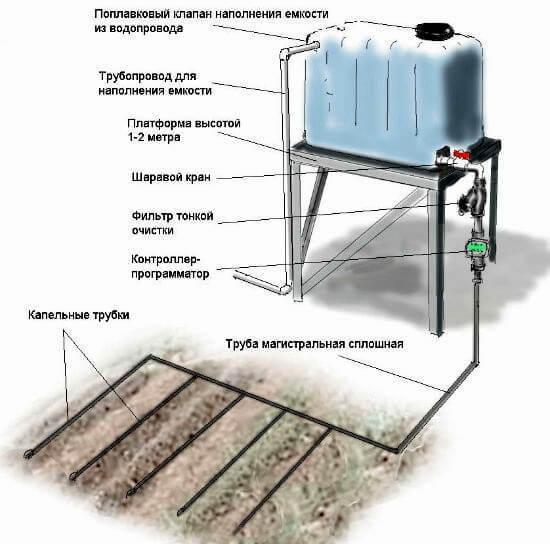
Piping
Since construction of the system, first determine the optimal method of laying pipes. Such methods are only two:
1. On the surface of the earth is suitable for seasonal watering (e.g., country). This method of piping allows you to completely remove the system at the end of the irrigation season and to protect the elements from damage (or theft).
2. Under the ground – suitable for use in areas intended for permanent residence. Pipes are installed in this case to a depth of at least 30 cm is to ensure that they cannot be damaged by tillers, cultivator or with a shovel.
I to your site want to make the main pipe along the midway, and from there the hoses with sprinklers – to the side. To the winter they can be collected and sent to storage, and then in the fall and spring quietly to plow with cultivator. Trenching carried out according to a predetermined scheme. If the main track is already growing on the lawn, along the future trenches should be lay the cellophane, which will be removed the soil.
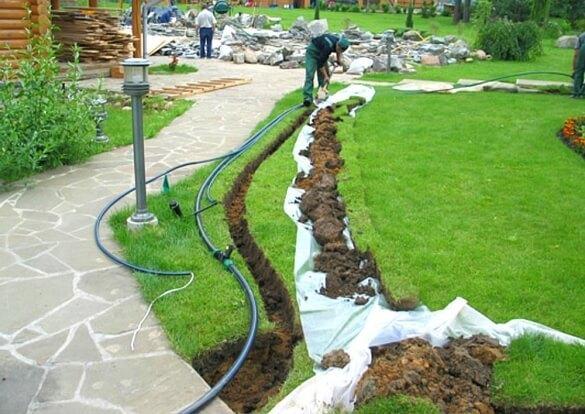
As for materials, the layout auto-irrigation often are assembled from plastic pipes. They do not corrode, have low internal resistance and easy to install. Ideally, you should use pipes made of low pressure polyethylene (HDPE). They are resistant to UV and can be connected by threaded compression fittings. This is their best contrast to polypropylene tubes, which are connected by welding. Indeed, in the event of an accident the system performance on the basis of polypropylene is difficult to recover.
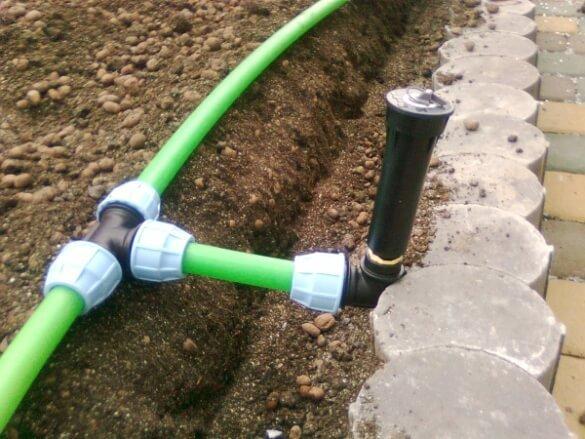
By the way, if part of the system are hidden under the ground, the thread connections for the HDPE pipe at the end of the watering season can be quickly dismantled and removed all the parts for winter storage.
It is important to ensure that equipment installed under the earth, was able without damage to move the frost. In order for the automatic irrigation system was able to survive the winter "without shocks", in its lower point organize the discharge of water. For this purpose you can use the valves to discharge water, which will be triggered when the pressure in the system below a certain value. After the valve the water from the system is removed by gravity. If the system has multiple watering circuits, the valves are appropriate to put on all the input lines. If the lower points on the site (if site is flat), it can be created artificially.
Dig the depth of frost with a small bias. The lowest point in the pit-the pit. In winter almost all the water should drain out. Drain valve it is better to set not just in a "well pit", and there is a drainage sump.
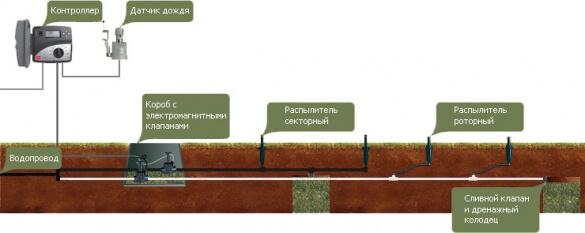
To preserve the system for the winter helps purge all its highways with compressed air (operating pressure 6 to 8 Bar), which is carried out without removing sprinklers and droppers. In addition, in all irrigation systems that are not expected to be removed for the winter, use a frost-proof equipment (for example, sprinklers with a drain valve).
Each water outlet and the sprinkler is antisemitisme valve, so I'm here for 5 years, never played off the water!For the winter water storage tanks drained, filters are cleaned, and pumps are dismantled and put into storage in a warm room.This wiring
All branches from main pipeline, as well as peripheral joints, valves, and tees should be placed in special hatches. Because these elements of the system are most problematic (typically, leaks occur in areas of the joints). But if the location of the problem areas known and access to them is open, the system maintenance becomes easier.

After all the underground elements of the system will be assembled and put into place, the system should be flushed. This will help remove debris that will interfere with the normal functioning of automatic irrigation.
In the next step the system, you can connect the drip tape and sprinklers. As for the sprinklers, that standard of the products purchased in specialized stores. At the same time to create a drip loop, you can use a ready-made drip tape, but there is an alternative – a regular watering hose, which after a specified period mounted dropper.
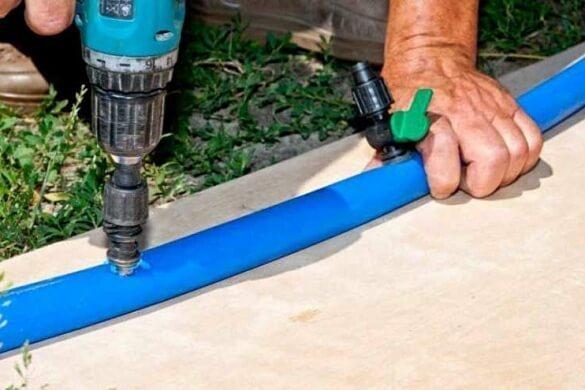
Pump station with all its elements, the unit of water allocation and programmer – all of these devices are installed at predetermined place to which electricity and water from the main source.
Optional elements of the system avtopolivom
In some cases, the main trunk of the irrigation system should be equipped with water outlets to connect a hose for hand watering, washing cars, and other needs. Rain sensors and temperature will disable the system if make watering impractical. All of these devices are established only on request.
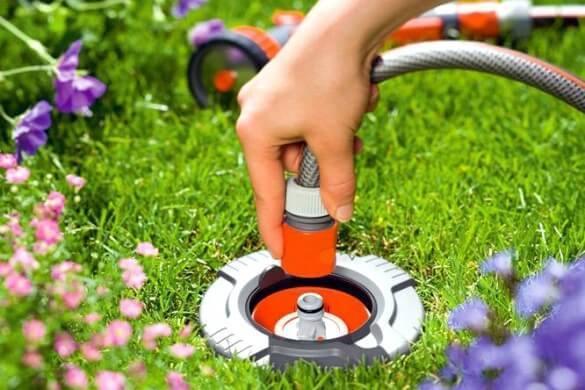
P. S. And remember, only by changing their consumption — together we change the world! ©
Source: www.forumhouse.ru/articles/house/6772
Varieties of watering plants and principles of location of irrigation equipment.
1. Sprinkler system – sprinkler systems that mimic the natural precipitation in the form of rain. Such installations are common due to its simplicity and ease of operation. Typically, they are used for watering lawns and flower beds. The basic principle of the arrangement of nozzles in sprinkler system is that the radius of irrigation of adjacent nozzles should overlap completely. That is, after irrigation on practically should not be left dry patches.
Ideally, polivalki to stand on the vertices of the triangles. In any case, each of the sprinklers should be watering at least one sprinkler.

2. Installer for basal drip (point) irrigation is an irrigation system that delivers water directly in the landing zone of the plant, the direction of the irrigating its root system. Such systems are mainly used for irrigation of trees, shrubs, greenhouses, and garden plants (for watering plants with a deep root system). The principle of arrangement of watering equipment in such systems is that water highway with watering drippers (drip tape) are placed along the planting rows at a small distance from the trunks of plants.

3. Installer for underground (subsurface) irrigation – sprinkler system, the functionality of which is similar to drip irrigation. The main difference is that the porous pipe for irrigation laid under the ground and deliver water directly to the root system of plants.
Humidifiers for subsurface irrigation (pipes with a round or slit-like holes) are located at a depth of 20...30 cm Distance between two adjacent lines is 40...90 cm (depends on the individual characteristics of irrigated culture and the type of soil). The interval between the holes of the humidifier is equal to 20...40 cm, the System of subsoil irrigation is problematic in terms of operation, so few dare to install it on their own site.

No matter what irrigation method you choose, the design of the automatic irrigation system will be built on the same principles. Significant differences would consist only in the use of different items for watering and that different systems have different working pressure.
So, gravity fed drip systems can function even when the pressure – 0.2 ATM.
The first work on the very small pressure from 0.2 to 0.8 ATM. Roughly speaking, those who have no water supply on the site, you can connect to the tank or barrel. However, the barrel should be raise to 1.5 – 2 meters.In overhead sprinkler irrigation the figure is much higher (several atmospheres). And it depends on the characteristics of the equipment used.
Schematic diagram of irrigation system
The basic elements combined (with the contours of drip and rain irrigation) installation of automatic irrigation shown in the diagram.

This scheme operates as follows: water from a source (using a pump or by gravity) is delivered to the irrigation zones through pipelines with a diameter of 1 – 1 1/2 inches. Watering zones in this case are equipped with tubes of small diameter (3/4 inch).
In addition to the source, part of an irrigation system is recommended to include storage tank. It could be darkened a tank having a volume of 2 m3 and above (depending on the flow of water when watering). Capacity is equipped with a float sensor fill. If it is put under direct sunlight, it will perform a double function: able to store and heat water in a quantity sufficient for one watering. Filled the tank with tap water, well or well. To prevent the growth of algae inside the tank, it can be darkened with black tape. As the primary water source for the auto-irrigation system, you cannot use natural bodies of water. Microorganisms and algae contained in the water, quickly take the irrigation system out of action. Zone rainfall irrigation are equipped with rotary (dynamic) or fan (static) spray. In areas of drip irrigation, laid the drip tape.
On the same line irrigation should be set to spray only the same type and same model. Otherwise, no one can guarantee their normal functioning. Solenoid valves installed in the distribution unit of water in a given time include the work of a certain contour irrigation.

The opening and closing of the electromagnetic valves are controlled using the controller (it is also called a programmer or computer watering) in accordance with the specified schedule. The programmer, usually installed near the distribution unit of water. The pump starts pumping water into the system automatically (in the time of the fall of pressure in the rail). And the pressure falls as soon as opens the solenoid valve.
To keep the system running smoothly, it is equipped with filters, installed directly into the main water supply.
To prevent clogging the filters, sprinklers, need to install a disk filter at the input or, better, at the outlet of the tank. The pumping station is indicated in the diagram, includes a water reservoir, a fine filter, check valve, purge the node (for preservation of the system in the winter), and a pump that supplies water to the irrigation line.

The figure shows the simplest equipment sprinkler systems. Depending on specific needs, the system can be equipped with additional elements, and some devices (for example, main pump, rain sensor, purge the node, solenoid valves, etc.), conversely, may be absent.
Creating a system of automatic irrigation, we have to follow some mandatory steps.
I would like to inform about the steps we will do to achieve the goal:Draw a detailed site plan with all existing objects. The selection and placement of sprinklers in the drawing. Ungrouping sprinkler zones (zone – a territory controlled by one valve). Calculation of hydraulics and pump selection. The calculation of the pipe sections and determination of pressure losses in the system. Buying components. The installation of the system. Steps 3-5 are performed in parallel, because a change to any parameter necessitates changes to the others. For example, if the sprinklers in one zone gets bigger, you need a more powerful pump, and this, in turn, leads to an increase of the pipe sections.
Consider these steps in more detail.
The site plan
The site plan we need to map the placement of watering equipment.

The plan is drawn to scale. It should outline the areas of irrigation, source of water, as well as free-standing plants (e.g., trees) that you plan to irrigate.
Development of a scheme of automatic irrigation
When the site plan is ready, it is possible to trace the route of pipelines. If you plan to create a zone rainfall irrigation, the diagram must indicate the place of installation of sprinklers, as well as their range.


If the area will create a zone of drip irrigation, its lines should also be marked on the overall scheme.
If the distance between the rows of plants, irrigated by drip method, exceeds 40 cm, each series must maintain separate irrigation line. If the specified distance is less, watering can be arranged in rows (to save tubes and droppers).

The calculation system
Drawing a detailed scheme of irrigation, it is possible to determine the length of the pipelines and calculate the exact number of points of irrigation (number of sprinklers and drippers).
As for the calculation of the pipe sections, as well as determine the volume of the reservoir and power pumping equipment, it's all very ambiguous. To make accurate calculations you will need to know the norm of watering all plants planted on the plot. Based on computing needs to take the theoretical knowledge of hydrodynamics, and this issue requires a separate study. Therefore, in order to avoid errors, it is better to seek the services of relevant experts or representatives of the company that sells components to the water-saving irrigation systems. They will be able to pick up the equipment and elements of the system that suit to your site.
If you want to do it yourself, simple solution to the problem concerning the calculation of the irrigation system, offers the user of our portal.
To do so, that all would be poured, just enough. Sprinkle each of the specified water flow. Adding the consumption of all sprinklers, you get total consumption. Further is selected the pump, where this total flow is at the pressure of 3-4 ATM. It turns out the so-called "working point". The pump flow should cover the needs of the irrigation system in water at least 1.5 times. In General, the course of thought is correct. When calculating, consider raising the height of the water and the resistance force of the fluid generated by the movement of water through the pipes, as well as when passing through a bifurcation (from large diameter to smaller). If the irrigation system is the combination (sprinkler and drip loop), errors in calculations can lead to unpleasant consequences.
From "the sufferings of little things": everything is always subject to the debit of the well (water source) and the pressure in the supply hose! No pressure – do not operate the sprinklers, too much pressure – tears drip hose. However, this problem is easily solved by install a reducer at the inlet to the drip line. The reducer allows to reduce the working pressure in the drip loop to 1,5...2 Bar. The line sprinkler irrigation will remain fully functional.
Line of drip irrigation can not connect to a common backbone leading from the pump if the tank is situated at altitude, able to provide efficient watering. If we are talking about a small drip irrigation system, then calculate it much easier. Moreover, such a system, as we have said, it can work without pump.
I have 3 years simple drip system: steel tub (200 l), and from it stretched the hoses with the droppers. About 17 bushes of cucumbers in the greenhouse are watered around the clock. Water goes by gravity.

Piping
Since construction of the system, first determine the optimal method of laying pipes. Such methods are only two:
1. On the surface of the earth is suitable for seasonal watering (e.g., country). This method of piping allows you to completely remove the system at the end of the irrigation season and to protect the elements from damage (or theft).
2. Under the ground – suitable for use in areas intended for permanent residence. Pipes are installed in this case to a depth of at least 30 cm is to ensure that they cannot be damaged by tillers, cultivator or with a shovel.
I to your site want to make the main pipe along the midway, and from there the hoses with sprinklers – to the side. To the winter they can be collected and sent to storage, and then in the fall and spring quietly to plow with cultivator. Trenching carried out according to a predetermined scheme. If the main track is already growing on the lawn, along the future trenches should be lay the cellophane, which will be removed the soil.

As for materials, the layout auto-irrigation often are assembled from plastic pipes. They do not corrode, have low internal resistance and easy to install. Ideally, you should use pipes made of low pressure polyethylene (HDPE). They are resistant to UV and can be connected by threaded compression fittings. This is their best contrast to polypropylene tubes, which are connected by welding. Indeed, in the event of an accident the system performance on the basis of polypropylene is difficult to recover.

By the way, if part of the system are hidden under the ground, the thread connections for the HDPE pipe at the end of the watering season can be quickly dismantled and removed all the parts for winter storage.
It is important to ensure that equipment installed under the earth, was able without damage to move the frost. In order for the automatic irrigation system was able to survive the winter "without shocks", in its lower point organize the discharge of water. For this purpose you can use the valves to discharge water, which will be triggered when the pressure in the system below a certain value. After the valve the water from the system is removed by gravity. If the system has multiple watering circuits, the valves are appropriate to put on all the input lines. If the lower points on the site (if site is flat), it can be created artificially.
Dig the depth of frost with a small bias. The lowest point in the pit-the pit. In winter almost all the water should drain out. Drain valve it is better to set not just in a "well pit", and there is a drainage sump.

To preserve the system for the winter helps purge all its highways with compressed air (operating pressure 6 to 8 Bar), which is carried out without removing sprinklers and droppers. In addition, in all irrigation systems that are not expected to be removed for the winter, use a frost-proof equipment (for example, sprinklers with a drain valve).
Each water outlet and the sprinkler is antisemitisme valve, so I'm here for 5 years, never played off the water!For the winter water storage tanks drained, filters are cleaned, and pumps are dismantled and put into storage in a warm room.This wiring
All branches from main pipeline, as well as peripheral joints, valves, and tees should be placed in special hatches. Because these elements of the system are most problematic (typically, leaks occur in areas of the joints). But if the location of the problem areas known and access to them is open, the system maintenance becomes easier.

After all the underground elements of the system will be assembled and put into place, the system should be flushed. This will help remove debris that will interfere with the normal functioning of automatic irrigation.
In the next step the system, you can connect the drip tape and sprinklers. As for the sprinklers, that standard of the products purchased in specialized stores. At the same time to create a drip loop, you can use a ready-made drip tape, but there is an alternative – a regular watering hose, which after a specified period mounted dropper.

Pump station with all its elements, the unit of water allocation and programmer – all of these devices are installed at predetermined place to which electricity and water from the main source.
Optional elements of the system avtopolivom
In some cases, the main trunk of the irrigation system should be equipped with water outlets to connect a hose for hand watering, washing cars, and other needs. Rain sensors and temperature will disable the system if make watering impractical. All of these devices are established only on request.

P. S. And remember, only by changing their consumption — together we change the world! ©
Source: www.forumhouse.ru/articles/house/6772
